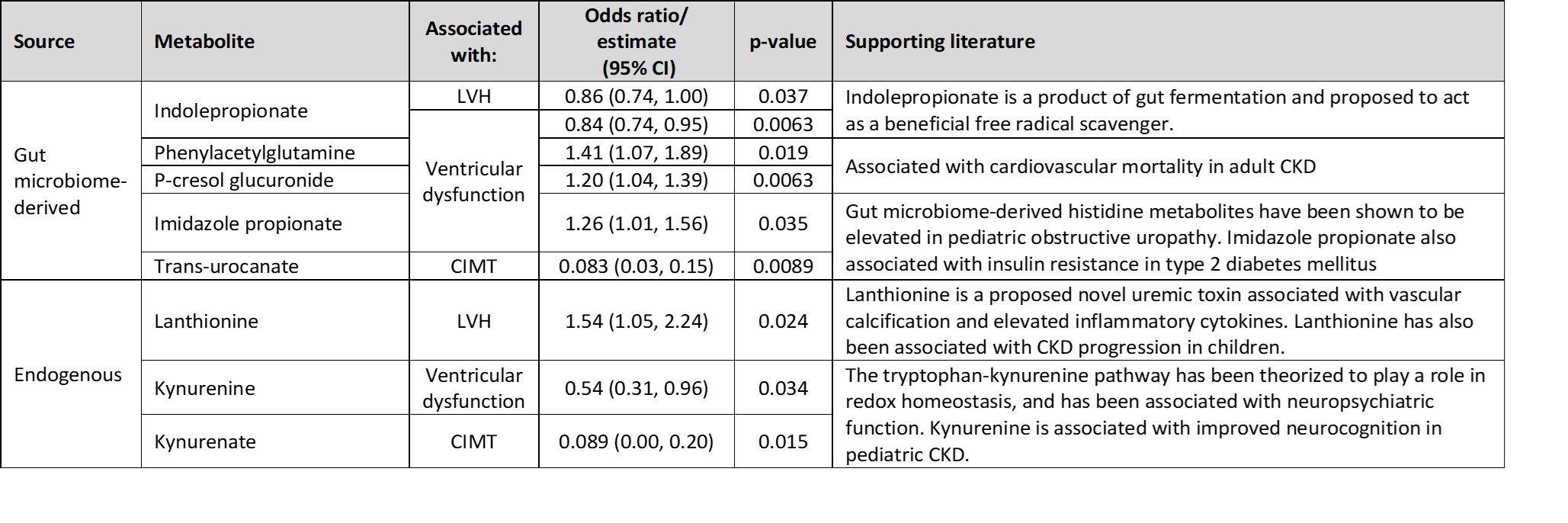Back
Nephrology: CKD
Category: Abstract Submission
Nephrology IV: Chronic Kidney Disease
67 - Metabolomic associations with cardiovascular risk markers in pediatric chronic kidney disease
Sunday, April 24, 2022
3:30 PM – 6:00 PM US MT
Poster Number: 67
Publication Number: 67.341
Publication Number: 67.341
Arthur M. Lee, Children's Hospital of Philadelphia, Philadelphia, PA, United States; Yunwen Xu, Johns Hopkins Bloomberg School of Public Health, Baltimore, MD, United States; Mark Mitsnefes, Cincinnati Children's Hospital Medical Center, Cincinnati, OH, United States; Jian O. Hu, University of Pennsylvania, Philadelphia, PA, United States; Rui Xiao, University of Pennsylvania, Philadelphia, PA, United States; Stephen R. Hooper, University of North Carolina at Chapel Hill, Chapel Hill, NC, United States; Erum A. Hartung, Children's Hospital of Philadelphia, Philadelphia, PA, United States; Amy Kogon, University of Pennsylvania, Philadelphia, PA, United States; Eugene Rhee, Massachusetts General Hospital, Boston, MA, United States; Vasan S. RAMACHANDRAN, Boston University School of Medicine, Boston, MA, United States; Paul L. Kimmel, NIDDK, Bethesda, MD, United States; BRADLEY A. WARADY, CHILDREN'S MERCY KANSAS CITY, KANSAS CITY, MO, United States; Susan Furth, Childrens Hospital of Philadelphia, Philadelphia, PA, United States; Michelle Denburg, Childrens Hospital of Philadelphia, Philadelphia, PA, United States
- AL
Arthur Lee, MD
Nephrology Fellow, PGY-4
Children's Hospital of Philadelphia
Philadelphia, Pennsylvania, United States
Presenting Author(s)
Background: Children with chronic kidney disease (CKD) have increased prevalence of cardiovascular (CV) risk markers: left ventricular hypertrophy (LVH), ventricular dysfunction, and increased carotid intima media thickness (CIMT).
Objective: A cross-sectional discovery analysis of untargeted metabolomic profiling can identify CV-metabolite associations in pediatric CKD.
Design/Methods: The Chronic Kidney Disease in Children (CKiD) study is a North American, multi-institutional, prospective cohort enrolling children aged 6-months to 16-years with estimated glomerular filtration rate (eGFR) 30-90ml/min/1.73m^2. This study leveraged baseline untargeted plasma metabolomic profiling (Metabolon Inc.), echocardiography, and standardized carotid ultrasonography (Cincinnati Cardiovascular Core Image Research Laboratory). Left ventricular mass index (LVMI) was indexed to height^2.7 and LVH was defined by LVMI >95th-percentile for age and sex. Ventricular dysfunction defined by abnormal shortening fraction ( < 0.25), diastolic filling or annular velocity (E/A or e’/a’ < 1.0), or filling pressure (E/e’ >8.0). Regressions of CV risk marker vs. log-2-transformed metabolite level adjusted for age, sex, BMI z-score, proteinuria, eGFR, hypertension (casual BP >95th-percentile or antihypertensive medication use), CKD duration, and glomerular diagnosis. Pathway enrichment analyses were performed. Metabolite associations with known CV risk markers (FGF23 and dyslipidemia) were also assessed.
Results: 485 participants (mean age=11.3 years, eGFR=54.3) had echocardiogram data (LVH n=53, ventricular dysfunction n=82). 111 participants had carotid ultrasound data (mean CIMT=0.43mm). 669 named, non-drug metabolites were analyzed. Table 1 shows notable CV-metabolite associations. In a subset analysis of participants with 24-hour ambulatory blood pressure monitoring data (echocardiogram n=358, CIMT n=83), all presented associations remained significant except kynurenine and kynurenate. Table 2 shows results of the pathway enrichment analyses. Indolepropionate (estimate=-11.86, p=0.021) associated with FGF23. 3-carboxy-4-methyl-5-propyl-2-furanpropanoate (OR=0.85, p=0.0045) and taurocholenate sulfate (OR=0.79, p=0.025) associated with dyslipidemia.Conclusion(s): This is a discovery analysis for metabolomic associations with CV risk in pediatric CKD. Longitudinal follow-up validation analyses will be performed. Identifying CV-metabolite associations may direct study of potential interventions such as: dietary changes and pharmacologic targeting of redox homeostasis and lipid signaling.
Arthur M. Lee CVleeam_2021_12_CV.pdf
Table 1: Notable metabolites associated with cardiovascular risk
Objective: A cross-sectional discovery analysis of untargeted metabolomic profiling can identify CV-metabolite associations in pediatric CKD.
Design/Methods: The Chronic Kidney Disease in Children (CKiD) study is a North American, multi-institutional, prospective cohort enrolling children aged 6-months to 16-years with estimated glomerular filtration rate (eGFR) 30-90ml/min/1.73m^2. This study leveraged baseline untargeted plasma metabolomic profiling (Metabolon Inc.), echocardiography, and standardized carotid ultrasonography (Cincinnati Cardiovascular Core Image Research Laboratory). Left ventricular mass index (LVMI) was indexed to height^2.7 and LVH was defined by LVMI >95th-percentile for age and sex. Ventricular dysfunction defined by abnormal shortening fraction ( < 0.25), diastolic filling or annular velocity (E/A or e’/a’ < 1.0), or filling pressure (E/e’ >8.0). Regressions of CV risk marker vs. log-2-transformed metabolite level adjusted for age, sex, BMI z-score, proteinuria, eGFR, hypertension (casual BP >95th-percentile or antihypertensive medication use), CKD duration, and glomerular diagnosis. Pathway enrichment analyses were performed. Metabolite associations with known CV risk markers (FGF23 and dyslipidemia) were also assessed.
Results: 485 participants (mean age=11.3 years, eGFR=54.3) had echocardiogram data (LVH n=53, ventricular dysfunction n=82). 111 participants had carotid ultrasound data (mean CIMT=0.43mm). 669 named, non-drug metabolites were analyzed. Table 1 shows notable CV-metabolite associations. In a subset analysis of participants with 24-hour ambulatory blood pressure monitoring data (echocardiogram n=358, CIMT n=83), all presented associations remained significant except kynurenine and kynurenate. Table 2 shows results of the pathway enrichment analyses. Indolepropionate (estimate=-11.86, p=0.021) associated with FGF23. 3-carboxy-4-methyl-5-propyl-2-furanpropanoate (OR=0.85, p=0.0045) and taurocholenate sulfate (OR=0.79, p=0.025) associated with dyslipidemia.Conclusion(s): This is a discovery analysis for metabolomic associations with CV risk in pediatric CKD. Longitudinal follow-up validation analyses will be performed. Identifying CV-metabolite associations may direct study of potential interventions such as: dietary changes and pharmacologic targeting of redox homeostasis and lipid signaling.
Arthur M. Lee CVleeam_2021_12_CV.pdf
Table 1: Notable metabolites associated with cardiovascular risk

